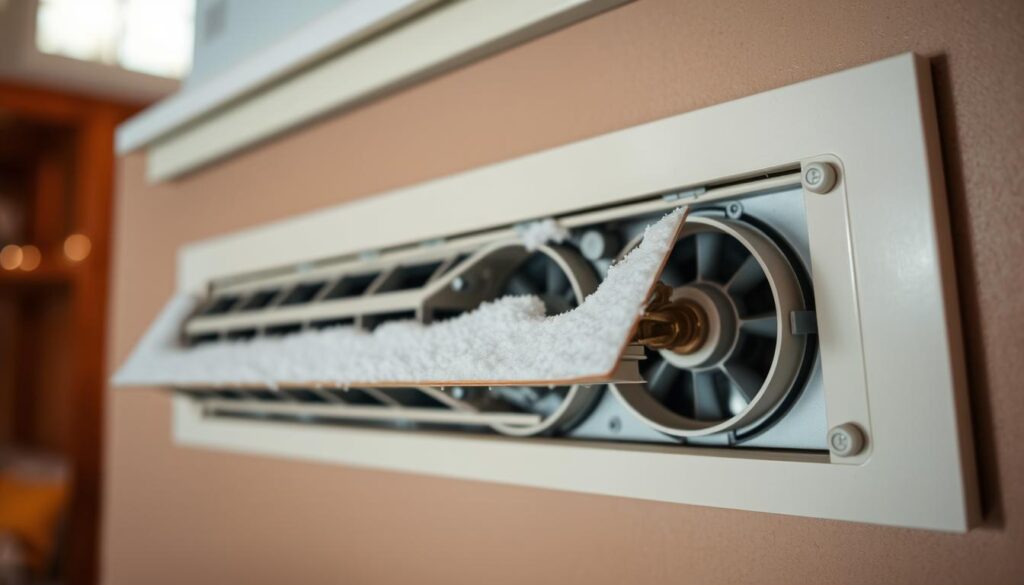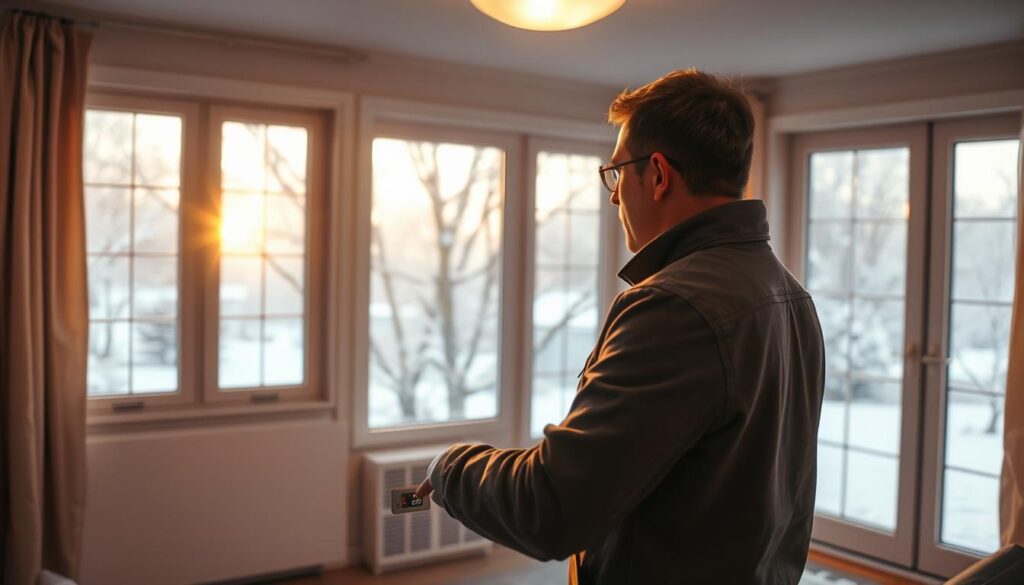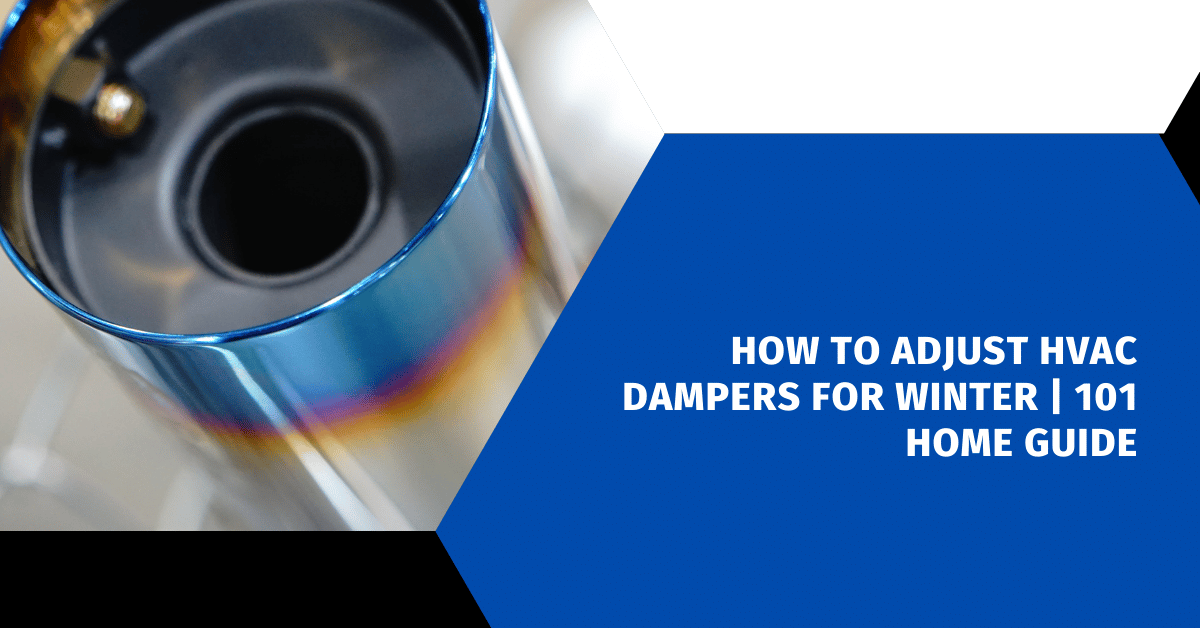Affiliate Disclosure
HVAC Guide Guys is a participant in the Amazon Services LLC Associates Program, an affiliate advertising program designed to provide a means for sites to earn advertising fees by advertising and linking to Amazon.
How to Adjust HVAC Dampers for Winter? Are you tired of uneven heating that leaves some rooms freezing while others feel like a sauna? Mastering winter HVAC damper adjustment could be the key to transforming your home’s comfort and energy efficiency.

HVAC dampers play a crucial role in regulating airflow throughout your home during the cold months. Understanding how to adjust HVAC dampers for winter can help you create a more balanced and comfortable living environment while potentially reducing your energy bills.
This guide will walk you through the essential steps of winter HVAC damper adjustment. You’ll get practical insights to optimize your home’s heating system. Whether you’re dealing with a multi-story home or struggling with temperature inconsistencies, you’ll learn how to take control of your indoor climate.
Key Takeaways
- HVAC dampers control airflow in different zones of your home
- Proper winter damper adjustment improves heating efficiency
- Different types of dampers require specific adjustment techniques
- Regular maintenance ensures optimal HVAC performance
- Professional help may be needed for complex damper systems
Table of Contents
Understanding HVAC Dampers and Their Role in Home Comfort
Winter brings unique challenges to home heating. Your HVAC system is key to keeping your home comfortable. HVAC dampers are the unsung heroes of balanced indoor temperatures. They help you achieve optimal hvac zoning for winter comfort.
What Are HVAC Dampers?
Think of HVAC dampers as intelligent valves in your ductwork. They control air movement in your home, just like a dam controls water flow. When balancing hvac system for cold weather, dampers act as precise controllers. They direct heated air exactly where you need it most.
How Dampers Control Airflow
Dampers work by opening and closing strategically to manage temperature distribution. They help you customize your home’s heating by:
- Redirecting warm air to specific rooms
- Preventing overheating in certain areas
- Ensuring consistent temperatures across different zones
Benefits of Proper Damper Adjustment
Mastering your HVAC dampers offers several advantages:
- Energy Efficiency: Reduce unnecessary heating in unused spaces
- Personalized Comfort: Create perfect temperature zones
- System Longevity: Minimize strain on your heating equipment
By understanding and implementing smart damper strategies, you can transform your home’s winter heating approach.
Locating Your HVAC Dampers
Finding your home’s HVAC dampers is a key first step. These parts control airflow in your heating system. They are usually hidden in your ductwork.
Most homes have dampers in certain spots. You should look in these areas:
- Main trunk lines near furnace or air handler
- Junction points between major duct branches
- Large rectangular or round ductwork
- Areas close to primary heating zones
Look for small metal levers or wing nuts on your ducts. These show where to adjust the dampers. Pro tip: Wear work gloves and use a flashlight when searching in tight or dark spaces.
“Understanding your damper locations is the foundation of efficient home heating management.” – HVAC Professional
In multi-story homes, dampers are at 90-degree angles in main ducts. Check your basement or utility room for easy access. Each primary duct line has two dampers for better control.
When adjusting dampers, a visual check and system map are crucial. They help improve your home’s heating in winter.
Explore Our HVAC Shop
Looking for top-rated HVAC tools, parts, and accessories? Visit our shop and find the perfect solution for your needs.
Visit the ShopDifferent Types of HVAC Dampers for Winter Use
Knowing about HVAC dampers is key for keeping your home cozy and energy-smart. The right damper system is vital for winter. Each type has its own strengths for managing air and heat.
Butterfly Flat Dish Dampers
Butterfly flat dish dampers look like small butterfly wings in your ducts. They offer precise control for better energy use. They’re great for homes, making it easy to adjust airflow.
- Compact design
- Smooth airflow control
- Easy to install
- Ideal for smaller duct systems
Blade Dampers
Blade dampers are a stronger choice for airflow management. They have two big blades that close slowly. They’re best for bigger HVAC systems needing more control.
| Damper Type | Airflow Control | Installation Complexity |
|---|---|---|
| Butterfly Flat Dish | Precise | Low |
| Blade Dampers | Substantial | Moderate |
Manual vs Automatic Dampers
There are two main damper types for HVAC maintenance. Manual dampers need you to adjust them by hand. Automatic dampers use electronics for control. Automatic ones are more convenient but cost more upfront.
- Manual Dampers: Lower cost, direct control
- Automatic Dampers: Smart technology, remote adjustment
Explore Our HVAC Shop
Looking for top-rated HVAC tools, parts, and accessories? Visit our shop and find the perfect solution for your needs.
Visit the ShopHow to Adjust HVAC Dampers for Winter
Learning to adjust HVAC dampers for winter can greatly improve your home’s heating. It’s all about finding the right balance to keep your home warm. This balance is key to making sure every room is cozy.
First, understand how air moves in your home. Warm air goes up, so upper floors are usually warmer. But lower floors can be chilly. You want to spread the heat more evenly.
- Locate the main damper controls in your ductwork
- Identify dampers for each floor and room
- Use a flashlight to inspect damper positions
To adjust dampers for winter, follow these steps:
- Open dampers wider for basement and ground floor
- Partially close dampers to upper-level rooms
- Make small, incremental adjustments
- Monitor temperature changes over several days
Be careful with the damper lever or wing nut. Slight turns can significantly impact your home’s heating distribution. You’re aiming for a balance that keeps upper floors from getting too hot and ensures lower floors stay warm.
| Floor Level | Damper Position | Expected Result |
|---|---|---|
| Basement | More Open | Increased Warmth |
| Ground Floor | Mostly Open | Consistent Heating |
| Upper Floors | Partially Closed | Reduced Overheating |
Remember, finding the right balance is about comfort and saving energy. Take your time, be careful, and ask for help if needed.
Seasonal Damper Adjustment Guidelines
Getting your home ready for winter needs careful planning. It’s not just about turning on the heat. You also need to make sure your home’s temperature is evenly distributed.
Adjusting your dampers right can make your home cozier and save energy. The trick is knowing when and how to adjust them.
Winter Position Settings
In winter, your damper settings are key for heat distribution. Here are some important tips:
- Close upper-level dampers to direct warm air to lower levels
- Make sure lower-level rooms get the most heat
- Guide airflow to focus on living areas
Temperature Distribution Principles
Knowing how heat moves in your home is crucial. Warm air naturally rises. So, placing dampers correctly can boost heating efficiency.
“Effective damper management is the secret to consistent home comfort during winter months.” – HVAC Professional
Timing Your Adjustments
The best time to tweak your dampers is before winter hits. Usually, this is:
- Check dampers in early fall
- Adjust them before the first cold weather
- Recheck settings halfway through winter
By following these steps, you’ll make your home warmer and more energy-smart all winter.
Optimizing Airflow for Two-Story Homes

Keeping your HVAC system balanced in two-story homes can be tough. Heat goes up, making floors different temperatures. This can make your home feel off and raise heating bills.
Knowing how to tweak dampers is crucial. It helps spread heat evenly and cuts down on heating costs. Upper floors tend to be warmer, while lower floors are cooler in winter.
- Close upper-level dampers partially to reduce excess heat
- Open lower-level dampers to improve warm air circulation
- Use the hand-over-vent method to test airflow
To see if your damper settings are right, get someone to help. Have them block vents with their hand. This shows if the damper is open or closed. It’s a simple way to check your home’s airflow.
| Floor Level | Damper Setting | Expected Result |
|---|---|---|
| Upper Floor | Partially Closed | Reduced Heat Accumulation |
| Lower Floor | Fully Open | Improved Warm Air Distribution |
Pro tip: Regularly adjusting your dampers can help maintain consistent temperatures and potentially lower your winter heating expenses.
Explore Our HVAC Shop
Looking for top-rated HVAC tools, parts, and accessories? Visit our shop and find the perfect solution for your needs.
Visit the ShopCommon Mistakes When Adjusting Winter Dampers
Adjusting winter hvac dampers can be tricky. Homeowners often make mistakes that hurt their home’s heating. Knowing these mistakes helps keep your home warm and cozy.
Getting the damper settings right needs careful attention and planning. Stay away from these common mistakes to keep your home warm and save energy.
Incorrect Damper Positions
- Closing dampers completely in unused rooms
- Blocking airflow to critical areas of your home
- Misaligning dampers during seasonal transitions
Wrong damper settings can lead to uneven temperatures. Partial closure is better than shutting them off completely. It keeps the system balanced.
Timing and Frequency Errors
- Adjusting dampers while HVAC system is running
- Making frequent, unnecessary changes
- Neglecting regular system checks
Adjusting winter hvac dampers should be done carefully. Always change settings when the system is off to avoid damage.
Balance Testing Problems
Getting balance testing right is key for winter comfort. Homeowners often make mistakes like:
- Using inaccurate temperature measurements
- Failing to use proper testing equipment
- Overlooking subtle airflow variations
Using professional thermometers and airflow meters helps. They ensure your home heats evenly.
Troubleshooting Temperature Imbalances

Getting the perfect winter home heating balance can be tough, even with the right HVAC damper adjustments. Temperature differences between rooms can still happen. This is because many factors can affect your home’s airflow during the heating season.
To find out why temperatures are off, start by checking each room carefully. Look for these common issues:
- Rooms with noticeable hot or cold spots
- Drafty areas near windows or doors
- Rooms with inconsistent temperature compared to other spaces
To improve airflow for the heating season, try these steps:
- Check and seal air leaks around windows and doors
- Inspect and improve home insulation
- Verify individual room vent functionality
- Evaluate your HVAC system’s overall performance
| Potential Cause | Recommended Action |
|---|---|
| Poor Insulation | Add weatherstripping or upgrade wall insulation |
| Air Leaks | Seal gaps with caulk or weatherproof materials |
| Blocked Vents | Clear obstructions and ensure proper airflow |
“Temperature consistency is key to home comfort during winter heating seasons.” – HVAC Experts
Professional tip: If you’ve tried DIY fixes but still have heating balance problems, it’s time to call an HVAC pro. They can do a detailed check and suggest special solutions for your home’s heating issues.
Explore Our HVAC Shop
Looking for top-rated HVAC tools, parts, and accessories? Visit our shop and find the perfect solution for your needs.
Visit the ShopMaintaining Your HVAC Damper System
Seasonal HVAC maintenance is key to keeping your home comfy and saving on heating costs. Your HVAC damper system needs regular care to work well and last long.
To keep your damper system in great shape, follow these important maintenance steps:
- Inspect dampers every three months for wear or damage
- Clean ductwork and damper surfaces to stop dust buildup
- Lubricate moving parts for smooth operation
- Check for air leaks around damper connections
Pro tip: Make a maintenance calendar to track your damper system’s health and performance.
“Regular maintenance can extend the life of your HVAC system and improve home comfort” – HVAC Professionals Association
Keeping detailed records is vital for seasonal HVAC maintenance. Make a log of damper positions, inspection dates, and any fixes. This helps you monitor system performance and spot issues early.
Consider these critical maintenance practices:
- Visual inspection of damper mechanisms
- Testing damper responsiveness
- Cleaning dust and debris
- Checking electrical connections for automatic dampers
By spending time on maintenance, you’ll make your HVAC system more efficient and reliable during winter.
Conclusion
Learning to adjust HVAC dampers for winter can greatly improve your home’s comfort and energy use. By knowing how to position dampers, you can make sure every room is just right. This means no more cold spots or uneven temperatures.
At first, adjusting dampers might seem hard. But with a bit of practice, it becomes easy. Each change helps your HVAC system work better, saving energy and money. It’s not just about being cozy; it’s about making your heating system efficient and smart.
Getting your home’s heating just right takes patience and a bit of trial and error. Start by mapping your home’s airflow and finding trouble spots. Then, make small changes to see how they work. Over time, you’ll get better at using dampers to keep your home warm and cozy.
Keep working on your damper skills, and think about getting help from HVAC experts. They can give you advice that fits your home perfectly. Spending time learning about your system now can pay off big time in the long run.

